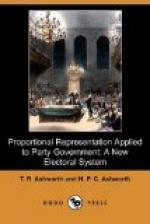The Block Vote was adopted in Australia for the election of ten delegates from each colony to the Federal Convention. This was a work in which all parties might fairly have joined together; and in most colonies the people did select the best men, regardless of party. In Victoria, however, the newspapers took on the role of the “machine,” and the ten candidates nominated by the Age were elected. Many of the supporters of the defeated candidates voted for some on the successful list who just defeated their own favourites. Had this been foreseen they would have thrown away these votes by giving them to those sure to be elected or to those least likely to be elected. The injustice of forcing each elector to vote for the whole ten is thus brought home. We are now threatened with the adoption of the Block Vote for the Federal Senate, and in some of the States for the House of Representatives as well; and it is in the hope of preventing this wrong that the present book is written.
So far we have been considering the Block Vote as applied to the election of a legislature with two or more parties; we now propose to consider it as applied to one party only. It is a matter of common knowledge that the Block Vote, when used for such an election as that of the committee of a club, works very well, and results in the return of the candidates most in general favour with all sections. The reason is, of course, that all sections work together, and members vote for the best men, regardless of sectional lines. We will go further and say that the Block Vote is by far the best method for such purposes, and is superior even to Preferential Voting. In the first place it is free from the defect that a small section can ensure the rejection of a general favourite; and in the second place it rests on at least as secure a theoretical basis. To fix our ideas, suppose there are ten candidates for five members of a committee. Laplace assumed (1) that each member would have a knowledge of the merits of all the ten candidates, (2) that his estimate of the respective candidates would vary arbitrarily between nothing and a maximum degree of merit, (3) that each member would express his honest preferences. The Block Vote, on the other hand, assumes (1) that each member can pick out the five best candidates, and therefore express his opinion as to how the committee should be constituted, (2) that he will be inclined to place these five candidates on one plane of favour and the other five on one plane of non-favour. We submit that the latter assumptions agree more closely with the actual state of affairs. The members can distinguish between candidates who have merit and those who have no merit or of whose merit they are ignorant; to force them, therefore, to place all the candidates in order of preference is to make them express preferences where none exist.[8] On the whole, then, the Block Vote is more likely to place the candidates in their real order of favour.




